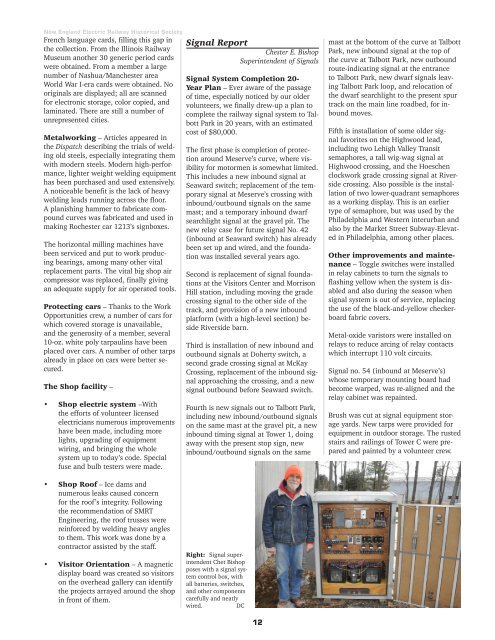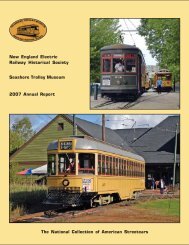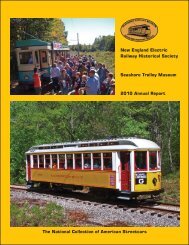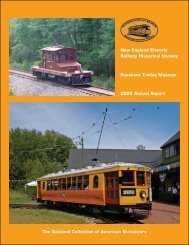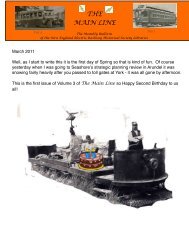2011 Annual Report - the Seashore Trolley Museum
2011 Annual Report - the Seashore Trolley Museum
2011 Annual Report - the Seashore Trolley Museum
You also want an ePaper? Increase the reach of your titles
YUMPU automatically turns print PDFs into web optimized ePapers that Google loves.
New England Electric Railway Historical Society<br />
French language cards, filling this gap in<br />
<strong>the</strong> collection. From <strong>the</strong> Illinois Railway<br />
<strong>Museum</strong> ano<strong>the</strong>r 30 generic period cards<br />
were obtained. From a member a large<br />
number of Nashua/Manchester area<br />
World War I-era cards were obtained. No<br />
originals are displayed; all are scanned<br />
for electronic storage, color copied, and<br />
laminated. There are still a number of<br />
unrepresented cities.<br />
Metalworking – Articles appeared in<br />
<strong>the</strong> Dispatch describing <strong>the</strong> trials of welding<br />
old steels, especially integrating <strong>the</strong>m<br />
with modern steels. Modern high-performance,<br />
lighter weight welding equipment<br />
has been purchased and used extensively.<br />
A noticeable benefit is <strong>the</strong> lack of heavy<br />
welding leads running across <strong>the</strong> floor.<br />
A planishing hammer to fabricate compound<br />
curves was fabricated and used in<br />
making Rochester car 1213’s signboxes.<br />
The horizontal milling machines have<br />
been serviced and put to work producing<br />
bearings, among many o<strong>the</strong>r vital<br />
replacement parts. The vital big shop air<br />
compressor was replaced, finally giving<br />
an adequate supply for air operated tools.<br />
Protecting cars – Thanks to <strong>the</strong> Work<br />
Opportunities crew, a number of cars for<br />
which covered storage is unavailable,<br />
and <strong>the</strong> generosity of a member, several<br />
10-oz. white poly tarpaulins have been<br />
placed over cars. A number of o<strong>the</strong>r tarps<br />
already in place on cars were better secured.<br />
The Shop facility –<br />
• Shop electric system –With<br />
<strong>the</strong> efforts of volunteer licensed<br />
electricians numerous improvements<br />
have been made, including more<br />
lights, upgrading of equipment<br />
wiring, and bringing <strong>the</strong> whole<br />
system up to today’s code. Special<br />
fuse and bulb testers were made.<br />
Signal <strong>Report</strong><br />
Chester E. Bishop<br />
Superintendent of Signals<br />
Signal System Completion 20-<br />
Year Plan – Ever aware of <strong>the</strong> passage<br />
of time, especially noticed by our older<br />
volunteers, we finally drew-up a plan to<br />
complete <strong>the</strong> railway signal system to Talbott<br />
Park in 20 years, with an estimated<br />
cost of $80,000.<br />
The first phase is completion of protection<br />
around Meserve’s curve, where visibility<br />
for motormen is somewhat limited.<br />
This includes a new inbound signal at<br />
Seaward switch; replacement of <strong>the</strong> temporary<br />
signal at Meserve’s crossing with<br />
inbound/outbound signals on <strong>the</strong> same<br />
mast; and a temporary inbound dwarf<br />
searchlight signal at <strong>the</strong> gravel pit. The<br />
new relay case for future signal No. 42<br />
(inbound at Seaward switch) has already<br />
been set up and wired, and <strong>the</strong> foundation<br />
was installed several years ago.<br />
Second is replacement of signal foundations<br />
at <strong>the</strong> Visitors Center and Morrison<br />
Hill station, including moving <strong>the</strong> grade<br />
crossing signal to <strong>the</strong> o<strong>the</strong>r side of <strong>the</strong><br />
track, and provision of a new inbound<br />
platform (with a high-level section) beside<br />
Riverside barn.<br />
Third is installation of new inbound and<br />
outbound signals at Doherty switch, a<br />
second grade crossing signal at McKay<br />
Crossing, replacement of <strong>the</strong> inbound signal<br />
approaching <strong>the</strong> crossing, and a new<br />
signal outbound before Seaward switch.<br />
Fourth is new signals out to Talbott Park,<br />
including new inbound/outbound signals<br />
on <strong>the</strong> same mast at <strong>the</strong> gravel pit, a new<br />
inbound timing signal at Tower 1, doing<br />
away with <strong>the</strong> present stop sign, new<br />
inbound/outbound signals on <strong>the</strong> same<br />
mast at <strong>the</strong> bottom of <strong>the</strong> curve at Talbott<br />
Park, new inbound signal at <strong>the</strong> top of<br />
<strong>the</strong> curve at Talbott Park, new outbound<br />
route-indicating signal at <strong>the</strong> entrance<br />
to Talbott Park, new dwarf signals leaving<br />
Talbott Park loop, and relocation of<br />
<strong>the</strong> dwarf searchlight to <strong>the</strong> present spur<br />
track on <strong>the</strong> main line roadbed, for inbound<br />
moves.<br />
Fifth is installation of some older signal<br />
favorites on <strong>the</strong> Highwood lead,<br />
including two Lehigh Valley Transit<br />
semaphores, a tall wig-wag signal at<br />
Highwood crossing, and <strong>the</strong> Hoeschen<br />
clockwork grade crossing signal at Riverside<br />
crossing. Also possible is <strong>the</strong> installation<br />
of two lower-quadrant semaphores<br />
as a working display. This is an earlier<br />
type of semaphore, but was used by <strong>the</strong><br />
Philadelphia and Western interurban and<br />
also by <strong>the</strong> Market Street Subway-Elevated<br />
in Philadelphia, among o<strong>the</strong>r places.<br />
O<strong>the</strong>r improvements and maintenance<br />
– Toggle switches were installed<br />
in relay cabinets to turn <strong>the</strong> signals to<br />
flashing yellow when <strong>the</strong> system is disabled<br />
and also during <strong>the</strong> season when<br />
signal system is out of service, replacing<br />
<strong>the</strong> use of <strong>the</strong> black-and-yellow checkerboard<br />
fabric covers.<br />
Metal-oxide varistors were installed on<br />
relays to reduce arcing of relay contacts<br />
which interrupt 110 volt circuits.<br />
Signal no. 54 (inbound at Meserve’s)<br />
whose temporary mounting board had<br />
become warped, was re-aligned and <strong>the</strong><br />
relay cabinet was repainted.<br />
Brush was cut at signal equipment storage<br />
yards. New tarps were provided for<br />
equipment in outdoor storage. The rusted<br />
stairs and railings of Tower C were prepared<br />
and painted by a volunteer crew.<br />
• Shop Roof – Ice dams and<br />
numerous leaks caused concern<br />
for <strong>the</strong> roof’s integrity. Following<br />
<strong>the</strong> recommendation of SMRT<br />
Engineering, <strong>the</strong> roof trusses were<br />
reinforced by welding heavy angles<br />
to <strong>the</strong>m. This work was done by a<br />
contractor assisted by <strong>the</strong> staff.<br />
• Visitor Orientation – A magnetic<br />
display board was created so visitors<br />
on <strong>the</strong> overhead gallery can identify<br />
<strong>the</strong> projects arrayed around <strong>the</strong> shop<br />
in front of <strong>the</strong>m.<br />
Right: Signal superintendent<br />
Chet Bishop<br />
poses with a signal system<br />
control box, with<br />
all batteries, switches,<br />
and o<strong>the</strong>r components<br />
carefully and neatly<br />
wired.<br />
DC<br />
12


